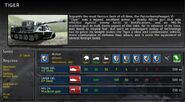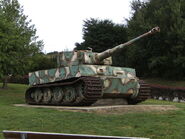| “ | A single Tiger could wipe out an armored column! - Andrew Campbell, Digging out the Fox |
” |
The German Panzerkampfwagen VI Ausf. E "Tiger" was probably the most feared tank ever built. When it came in action in 1942, the Western Allies had no weapons that could touch it. Its 88mm gun could take out any Allied tank at ranges over 1500 meters especially when in column. To take out one Tiger, the Americans needed at least 5 Shermans. If they managed to take the Tiger out, probably one or two Shermans came back out of five. Same went for the Soviets, who, however, had been expecting German super-heavies for some time and had a few surprises of their own.
The Tiger was a tactical masterpiece. Besides that it was an industrial nightmare. It costed huge amounts of resources and man hours to build this 56 ton monster. For it's weight, It's mobility was quite good. It's top speed was around the 40 km an hour. It also lacked sloped armor, something pretty much all modern day tanks had. The Panther came into service in 1943 and outclassed the Tiger in almost every way, except in firepower.
History[]
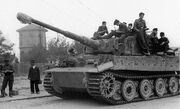
German industry first began working on heavy tank designs in 1937, even though it was believed at the time that the PzKpfw III and IV would be more than adequate for the coming battles. But when the German Panzers in Russia encountered the Soviet T-34's and KV-1's in 1941 it was all too apparent that a new heavy tank was needed. Ultimately, this resulted in a specification for a 45-ton tank with an 88mm gun, heavy armor, speed and maneuverability. The Porsche firm began working on this new tank design but encountered serious complications. The Henschel firm then began working on its own model under the direction of Dr. Erwin Aders, drawing from its previous work on heavy tank designs. The two firms were to have prototypes ready for inspection by Hitler at Rastenburg on his birthday, April 20th, 1942. The Porsche and Henschel tanks were put through trials and, in spite of Dr. Ferdinand Porsche's friendship with Hitler, the Henschel tank won, in large part due to its superior manoeuvrability.
Production was ordered to start in August 1942. It began at a rate of 25 tanks per month and peaked in April 1944 at a rate of 104 per month. It took 300,000 man hours to build one Tiger, almost twice as much time as a Panther required.
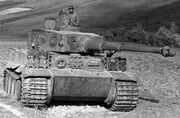
When it was introduced, the Tiger was the most powerful tank in the world. The 88mm gun was extremely powerful and the heavy armor made it almost impervious to attack. Even though its fearsomeness was to grow to almost mythical proportions, its combat debut was less than impressive. The first 4 Tigers to see combat were sent to the Leningrad area in August of 1942. Unfortunately they were deployed single file over swampy terrain and in their first day of combat all four were knocked out, although their armor was not penetrated. Three were later recovered. In spite of this bad start, Tiger tactics were soon developed and other units were quickly trained and equipped with the Tiger. By the end of 1942, Tiger formations had been deployed to Russia, Africa, and Italy. Training centers were established in both Germany and France and eventually Tigers would be in service with ten Heer heavy tank battalions, one training battalion, three SS heavy tank battalions, and the Grossdeutschland Panzer Grenadier Division . A few additional formations received limited numbers of Tigers.
The Tigers built an impressive record in Russia during 1943 and '44. They destroyed tremendous amounts of enemy equipment and often just the sight of a Tiger would induce the Russian tankers to withdraw. They had similiar success in North Africa and Italy, creating a powerful psychological effect on Allied troops. On Feb. 1, 1943 the British captured a Tiger intact and subsequently performed exhaustive tests on it. To their dismay, they found the Tiger was indeed an excellent gun platform and extremely well protected from all but their biggest anti-tank guns.
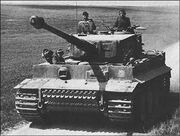
Throughout the war, the Tiger's greatest weakness was poor mechanical reliability. If preventive maintenance was not performed regularly, the transmission would soon fail due to the great weight of the machine. The result was a great number of Tiger's abandoned and destroyed by their crews due to mechanical breakdown. Recovery was a constant problem because of the Tiger's weight, with only the absolute largest recovery vehicles being able to tow a stricken vehicle. It often took several of these to do the job and, even though it was forbidden by regulations, the Tigers themselves were often forced to tow their comrades out of trouble. The overlapping roadwheels also caused problems, sometimes becoming clogged with frozen mud and debris. This could cause the tank to throw a track or simply be frozen in place. The sheer size of the tank was another weakness. Many bridges could not support it's weight and any routes it took had to be scouted out to ensure the roads were wide enough. Special rail cars had to be used to transport it. Special transport tracks which were narrower had to be fitted for rail travel, a job which was not relished by the crews.
Overview[]
- The Tiger tank is a monster on the battlefield. By itself it can engage several light tanks with ease, along with a few medium tanks. When deployed in numbers (if your economy permits) it can seriously change the outcome of the battle.
- Its best operating period is 1942, when there are little anti-tank weapons powerful enough to take it out. The only real threats the Tiger has are overwhelming numbers of similarly-powerful tanks, fortified positions, and fighter-bombers.
- The Tiger is more comfortable in defense than attack, with it being so slow and the distances it can fire so great. If possible, let the medium and light tanks engage in attacking and the Tiger stay in defense.
- It is best to keep the Tiger tanks at a distance, as their slow rate of fire gives them a disadvantage at close range, where faster firing medium tanks can easly overwhelm them.
- The Tiger will be at it's weakest when going through cities, as it's slow speed and turret traverse hampers it's offensive function, and The Tiger be prone to airstrikes and Infantry ambush.
- Even though the Tiger has a weaker gun compared to most advanced tank destroyers, the use of the Tiger in defence can be very beneficial because of the use of the turrets that most tank destroyers don't have, and with equal range and good recon, Tigers can take out the toughest of enemies.
- The Tiger may also be used as a breakthrough tank because of it's firepower and armor, with other tanks following it, but note that the Tiger's slow speed made it vulnerable and so it must be individually watched when used as a breakthrough tank.
- In 1945, although the Tiger still does have a very powerful presence, it may be outdated to fight the more mobile American Pershings or the more heavily armored Soviet IS-2 s, the upgrade to the King Tiger may be seen as necessary and beneficial, since the King Tiger has better armor, firepower and to some extent, speed; however, strategically using several Tiger I tanks protected by infantry and anti-aircraft guns, along with recons, can have the same effect with the King Tiger, and it will not further burden the economy.
Pros & Cons[]
This section is a stub, so be patient and expand it.
Weapons[]
| Weapon | ||||||||||
|---|---|---|---|---|---|---|---|---|---|---|
Huge cal. HE shell |
36 | 36 | 36 | 7 | 4 | 2 | 1 | 0 | 500m |
| Weapon | ||||||||||
|---|---|---|---|---|---|---|---|---|---|---|
Large cal AP shell |
400 | 100 | 50 | 25 | 20 | 12 | 500m |
| Weapon | ||||||||||
|---|---|---|---|---|---|---|---|---|---|---|
MG 34 Machine-gun |
26 | 26 | 250m |
Gallery[]
See also[]
| ||||||||||||||||||||||||||

